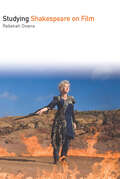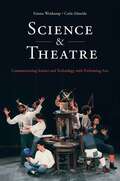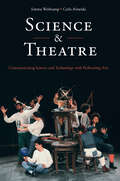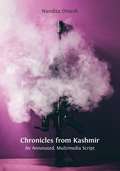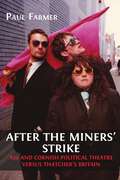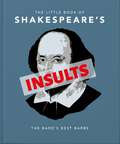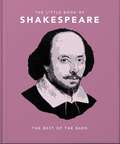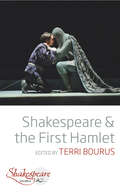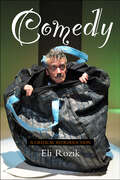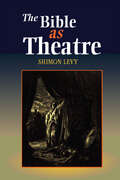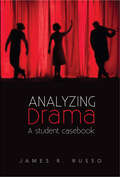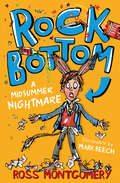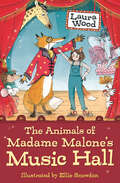- Table View
- List View
Lope de Vega: Fuente Ovejuna (Aris & Phillips Hispanic Classics)
Fuente Ovejuna (C.1613) is the most famous and frequently performed play by the creator of Spanish theatre, Lope de Vega (1562-1635). Astonishingly for its period, it celebrates the murder in 1476 of a nobleman, the Grand Commander of the Military Order of Calatrava, by the peasants he had oppressed, and their subsequent solidarity under torture. Fuente Ovejuna , however, is less a history lesson or political tract than an optimistic moral fable. Spanish text with facing-page translation, introduction and notes.
Calderon: The Schism in England: La cisma de Inglaterra (Aris & Phillips Hispanic Classics)
by Kenneth MuirAdmired by Shelley for 'its satisfying completeness', this thought-provoking and skilfully constructed play, which dramatizes the same subject as Shakespeare's Henry VIII , is one of its creator's most outstanding achievements. Understandably, Calderon offers an interpretation of King Henry's divorce from Catherine of Aragon and break with the Church of Rome which is markedly different from that given in Shakespeare's work. Yet, despite his Counter-Reformation allegiances, Calderon brings Henry VIII sympathetically to dramatic life. The schismatic English monarch is portrayed by the Roman Catholic Spanish playwright as a man endowed with moral awareness and with exceptional talent for spiritual leadership, who is, nevertheless, morally and spiritually destroyed by his extraordinary surrender to the forces of physical passion. In this first published translation of the play into English Kenneth Muir and Ann MacKenzie have adhered to methods effectively adopted in their previous books ( Four Comedies by Calderon, and Three Comedies by Calderon). They have composed, almost entirely in blank verse, an accurate yet elegantly poetic version, after the manner of the Elizabethans, but avoiding vocabulary which might seem affected to a modern audience, in order to produce a 'script' that could be performed with success on the stage. The critical edition, prepared by Ann Mackenzie to accompany the translation, is based on the editio princeps (published by Vera Tassis in Calderon's Octava parte de comedias [Madrid, 1684]). Her substantial Introduction and comprehensive Commentary together constitute the most detailed critical evaluation accomplished to date of this key-drama from the Golden Age in Spain. The Introduction, in particular, supplies new evidence as to the date of the play (1627) and the circumstances of its composition, and provides an analysis of Calderon's creative treatment of his historical source-work: Ribadeneyra's Historia eclesiastica del cisma del reino de Inglaterra (1588). Spanish text with facing-page translation, introduction and commentary .
Gil Vicente: Three Discovery Plays: Auto da Barca do Inferno, Exortacao da Guerra, Auto da India (Aris & Phillips Hispanic Classics)
by Anthony LappinThe three plays edited and translated in this volume are strongly linked to what we now think of as the Portuguese Discoveries. All three are fundamentally concerned with the expansion of Portugal in Africa and India through either crusade or commerce. In the introductions to the plays, the playwright's social role as a court dramatist is emphasized and his dramatic productions are set firmly within the political concerns of his time. Careful consideration is given to the involvement of both Gil Vicente and the Inquisition in the later emendation of the play's texts.
Macbeth (Devil's Advocates)
by Rebekah OwensWhy write about Roman Polanski's Macbeth (1971) as part of a series of books dedicated to the classics of the horror movie genre? Because, Rebekah Owens argues, just as Banquo in Polanski's film holds up a series of mirrors that reflect images of his successors that trace back to his own son Fleance, so subsequent milestones in the genre show their lineage to this work, their originator. Polanski had previously made Repulsion (1965) and Rosemary's Baby (1968), so he was fully aware of the conventions of the horror genre and this film provides clues to his own horror lexicon. This book demonstrates how Macbeth can be read as part of the British Folk tradition, strengthening the reading of the film as a horror movie in its own right through its links to The Wicker Man (1973), Blood on Satan's Claw (1971) and Witchfinder General (1968) then argues the case for its recognition as a horror movie even further, by connecting it to the later American horror classics, such as Halloween (1978). It also explores the popular associations made between the film and Polanski's own life, arguing that they endorse the view of the film as a horror. This book represents the first serious attempt to regard Polanski's Macbeth as a horror film in its own right, and not exclusively as one of a multitude of ongoing Shakespeare film adaptations.
Studying Shakespeare on Film (Studying Films)
by Rebekah OwensAimed at newcomers to literature and film, this book is a guide for the analysis of Shakespeare on film. Starting with an introduction to the main challenge faced by any director—the early-modern language—there follows exemplars for examining how that challenge is met using as case studies twelve films most often used in classroom teaching, including Romeo and Juliet, Macbeth, and The Tempest.The first chapter explores how a director can tell the story in a setting that embraces the expectations of realism in cinema, but still pays homage to the theatrical origins of the work. The second chapter discusses films in which the setting provides a visual analogy with the preoccupations of the story, but not at the expense of Shakespeare's language. The third chapter extends this to show how some films use recent history as a setting, adding a further layer of meaning to the story from the cultural resonances associated with that historical past. These films also rely on an assumption that Shakespeare is so well-known as to form a distinctive, easily recognized brand in the cinema marketplace. Thus, his work can be reimagined in completely different genres such as those films that are the subject of the final chapter.
Science & Theatre: Communicating Science and Technology with Performing Arts
by Emma Weitkamp Carla AlmeidaThere has been a significant growth in initiatives involving theatre, drama and performance within a science communication context. Yet there is little scholarship exploring this phenomenon from a science communication perspective. Weitkamp and Almeida draw on their distinct experiences with theatre in the context of science communication to delve into initiatives created through dialogue between the arts and the sciences for the purpose of public engagement. Entering into the space where museums, universities and research centres operate, as well as the space of theatre practitioners, they explore the richness and plurality of this universe, combining theory and practice, as well as presenting context, knowledge gaps and new data. Acknowledging that the place of drama, theatre and performance within science communication is one which is uniquely influenced by local cultural practices, discourses and expectations, the authors take a global perspective. Firstly by analysing data from an international survey of practitioners and secondly by curating a collection of case studies on science-theatre projects undertaken around the world. The chapters illustrate the diversity of forms and content that comprises contemporary science-theatre in this context and characterise theatre produced within the scope of science communication, placing it more precisely in the broader context of science-theatre.
Science & Theatre: Communicating Science and Technology with Performing Arts
by Emma Weitkamp Carla AlmeidaThere has been a significant growth in initiatives involving theatre, drama and performance within a science communication context. Yet there is little scholarship exploring this phenomenon from a science communication perspective. Weitkamp and Almeida draw on their distinct experiences with theatre in the context of science communication to delve into initiatives created through dialogue between the arts and the sciences for the purpose of public engagement. Entering into the space where museums, universities and research centres operate, as well as the space of theatre practitioners, they explore the richness and plurality of this universe, combining theory and practice, as well as presenting context, knowledge gaps and new data. Acknowledging that the place of drama, theatre and performance within science communication is one which is uniquely influenced by local cultural practices, discourses and expectations, the authors take a global perspective. Firstly by analysing data from an international survey of practitioners and secondly by curating a collection of case studies on science-theatre projects undertaken around the world. The chapters illustrate the diversity of forms and content that comprises contemporary science-theatre in this context and characterise theatre produced within the scope of science communication, placing it more precisely in the broader context of science-theatre.
Chronicles from Kashmir: An Annotated, Multimedia Script (Applied Theatre Praxis #2)
by Nandita DineshWhat is happening in Kashmir?’ Chronicles from Kashmir explores this question through a site-adaptive 24-hour theatrical performance. Developed between 2013 and 2018 by the Ensemble Kashmir Theatre Akademi and Nandita Dinesh, the play uses a durational, promenade format to immerse its audience within a multitude of perspectives on life in Kashmir. From a wedding celebration that is interrupted by curfew, to schoolboys divided by policing strategies, and soldiers struggling with a toxic mixture of boredom and trauma, Chronicles from Kashmir uses performance, installation and collaborative creation to grapple with Kashmir’s conflicts through the lenses of outsiders, insiders, and everyone in between. Due to varying degrees of censorship and suppression, the play has not been performed live since 2017. This book is, therefore, an attempt to keep Chronicles from Kashmir alive by including filmed scenes, a script, contextual questions, a glossary, and illuminating introductions by Nandita Dinesh and EKTA founder Bhawani Bashir Yasir. A valuable Open Access resource for practitioners, educators and students of performance and conflict, this book is also stimulating reading for anybody who has asked, ‘What is happening in Kashmir?’ This playscript includes: Twenty filmed scenes of the play in performance A range of contextual questions to stimulate discussion on staging site-adaptive theatre in places of conflict A helpful glossary
Performing Deception: Learning, Skill and the Art of Conjuring
by Brian RappertIn Performing Deception, Brian Rappert reconstructs the practice of entertainment magic by analysing it through the lens of perception, deception and learning, as he goes about studying conjuring himself. Through this novel meditation on reasoning and skill, Rappert elevates magic from the undertaking of mere trickery to an art that offers the basis for rethinking our possibilities for acting in the modern world. Performing Deception covers a wide range of theories in sociology, philosophy, psychology and elsewhere in order to offer a striking assessment of the way secrecy and deception are woven into social interactions, as well as the illusionary and paradoxical status of expertise.
Life, Re-Scaled: The Biological Imagination in Twenty-First-Century Literature and Performance
by Liliane Campos and Pierre-Louis PatoineThis edited volume explores new engagements with the life sciences in contemporary fiction, poetry, comics and performance. The gathered case studies investigate how recent creative work reframes the human within microscopic or macroscopic scales, from cellular biology to systems ecology, and engages with the ethical, philosophical, and political issues raised by the twenty-first century’s shifting views of life. The collection thus examines literature and performance as spaces that shape our contemporary biological imagination. Comprised of thirteen chapters by an international group of academics, Life, Re-Scaled: The Biological Imagination in Twenty-First-Century Literature and Performance engages with four main areas of biological study: ‘Invisible scales: cells, microbes and mycelium’, ‘Neuro-medical imaging and diagnosis’, ‘Pandemic imaginaries’, and ‘Ecological scales’. The authors examine these concepts in emerging forms such as plant theatre, climate change art, ecofiction and pandemic fiction, including the work of Jeff Vandermeer, Jon McGregor, Jeff Lemire, and Extinction Rebellion’s Red Rebel Brigade performances. This valuable resource moves beyond the biological paradigms that were central to the nineteenth and twentieth centuries, to outline the specificity of a contemporary imagination. Life, Re-Scaled is crucial reading for academics, scholars, and authors alike, as it proposes an unprecedented overview of the relationship between literature, performance and the life sciences in the twenty-first century.
After the Miners’ Strike A39 and Cornish Political Theatre versus Thatcher’s Britain: (pdf)
by Paul FarmerIn this rich memoir, the first of two volumes, Paul Farmer traces the story of A39, the Cornish political theatre group he co-founded and ran from the mid-1980s to the early 1990s. Farmer offers a unique insight into A39’s creation, operation, and artistic practice during a period of convulsive political and social change. The reader is plunged into the national miners’ strike and the collapse of Cornish tin mining, the impact of Thatcherism and ‘Reaganomics’, and the experience of touring Germany on the brink of reunification, alongside the influence on A39 of writers Bertolt Brecht, John McGrath and Keith Johnstone. Farmer, a former bus driver turned artistic director, details the theatre group’s inception and development as it fought to break down social barriers, attract audiences, and survive with little more than a beaten-up Renault 12, a photocopier and two second-hand stage lights at its disposal: the book traces the progress from these raw materials to the development of an integrated community theatre practice for Cornwall. Farmer’s candour and humour enliven this unique insight into 1980s theatre and politics. It will appeal to anyone with an interest in theatre history, life in Cornwall, and the relationship between performance and society during a turbulent era.
The Little Book of Shakespeare's Insults: Biting Barbs and Poisonous Put-Downs (The\little Book Of... Ser.)
by Orange Hippo!Away, you scullion, you rampallion, you fustilarian! Along with penning some of the most sublime passages in all of English Literature, Shakespeare was a master when it came to casting a wicked comeback or hurling a barbed insult. Whether it's Prospero calling Caliban a 'freckled whelp, hag-born' in The Tempest or King Lear railing against his daughter Goneril with the damning words, 'Thou art a boil, a plague sore, an embossed carbuncle in my corrupted blood', Shakespeare didn't hold back when it came to getting creative with his slights. Packed full of eloquent stings and poisonous putdowns, this is the perfect resource for anyone looking to scorn an enemy – without resorting to swearing! 'Away, you starvelling, you elf-skin, you dried neat's-tongue, bull's-pizzle, you stock-fish!' Henry IV Part I (Act 2, Scene 4). 'Away, you three-inch fool.' The Taming of the Shrew (Act 4, Scene 1). 'Go, prick thy face, and over-red thy fear, Thou lily-liver'd boy.' Macbeth (Act 5, Scene 3). 'The tartness of his face sours ripe grapes.' The Comedy of Errors (Act 5, Scene 4).
The Little Book of Shakespeare: Timeless Wit and Wisdom (The\little Book Of... Ser.)
by Orange Hippo!'He was "not of an age, but for all time".' (Shakespeare's contemporary Ben Jonson) No writer, before or since, has matched Shakespeare in terms of influence, critical acclaim or popular success. His genius lay in his sheer dramatic skill, his powerful use of imagery and his astonishing ability to create richly imagined characters. Packed full of the Bard's clever insights, witty asides and timeless nuggets of wisdom, and complemented by fascinating facts about his life and talents, this Little Book showcases some of the most remarkable lines ever crafted in the English language.SAMPLE QUOTES: 'What's in a name? That which we call a rose By any other word would smell as sweet.' - Romeo and Juliet, Act 2, Scene 2'We are such stuff as dreams are made on, and our little life is rounded with a sleep.' - The Tempest, Act 4, Scene 1'Cowards die many times before their deaths; The valiant never taste of death but once.' - Julius Caesar, Act 2, Scene 2SAMPLE FACT: There is evidence that Shakespeare wrote a play called Cardenio, which was performed by the King's Men in 1613. No known copy of the play exists today.
Shakespeare and the First Hamlet (Shakespeare & #9)
by Terri BourusThe first edition of Hamlet – often called ‘Q1’, shorthand for ‘first quarto’ – was published in 1603, in what we might regard as the early modern equivalent of a cheap paperback. Yet this early version of Shakespeare’s classic tragedy is becoming increasingly canonical, not because there is universal agreement about what it is or what it means, but because more and more Shakespearians agree that it is worth arguing about. The essays in this collected volume explore the ways in which we might approach Q1’s Hamlet, from performance to book history, from Shakespeare’s relationships with his contemporaries to the shape of his whole career.
You Wouldnt Want To Be Married To Henry Viii!
by Fiona Macdonald David AntramDivorced, beheaded, and died. Divorced, beheaded, survived! Uncover the secret lives of Henry VIII's ill-fated wives and what life was like as a Tudor queen. Henry VIII has asked for your hand in marriage, but marrying the King was no easy option. Henry VIII was a powerful, ruthless leader, with a track history of beheadings, adultery and scandal. Set against the turbulent backdrop of the Tudor court, this book explores Henry and his many wives - what went right, what went wrong, and what ultimately became of them all. With information on the church's break with Rome and the roles of key figures, such as Wolsey and Cranmer, this treacherous guide is the perfect curriculum companion to the Tudor period. The ever-popular You Wouldn't Want to Be series transports readers to the grisliest times and places in history, perfect for reluctant readers. The first-person narrative approach puts children in the shoes of some of the most unfortunate people ever to have lived.
La discreta enamorada / The Cleverest Girl in Madrid: Lope de Vega (Aris & Phillips Hispanic Classics)
This book is a Spanish/English edition of Lope de Vega’s La discreta enamorada. The core of the book consists of two texts: a critical edition of Lope’s play in Spanish and Donald R. Larson’s English translation/adaptation of that work. Common to the two texts are explanatory notes focusing on historical, cultural, and literary references. The Spanish text is further clarified by elucidations of difficult words or passages. The texts are preceded by a substantial introduction (discussing conventions of comedy, the comedia de capa y espada and its variation known as the comedia urbana, the political, social, and economic contexts of early 17th-century Madrid) and are followed by a critical apparatus that lists important variants that may be found in previous editions of Lope’s play.
Charles Macklin and the Theatres of London (Eighteenth-Century Worlds #11)
Charles Macklin (1699?–1797) was one of the most important figures in the eighteenth-century theatre. Born in Ireland, he began acting in London in around 1725 and gave his final performance in 1789 – no other actor can claim to have acted across seven decades of the century, from the reign of George I to the Regency Crisis of 1788. He is credited alongside Garrick with the development of the natural school of acting and gave a famous performance of Shylock that gave George II nightmares. As a dramatist, he wrote one of the great comic pieces of the mid-century (Love à la Mode, 1759), as well as the only play of the century to be twice refused a performance licence (The Man of the World, 1781). He opened an experimental coffeehouse in Covent Garden, he advocated energetically for actors’ rights and copyright reform for dramatists, and he successfully sued theatre rioters. In short, he had an astonishingly varied career. With essays by leading experts on eighteenth-century culture, this volume provides a sustained critical examination of his career, illuminating many aspects of eighteenth-century theatrical culture and of the European Enlightenment, and explores the scholarly benefit – and thrill – of restaging Macklin’s work in the twenty-first century.
Comedy: A Critical Introduction
by Eli RozikHerewith an original approach to the study of comedy. While assimilating theoretical insights from Aristotle to the present day, it contests, inter alia, the theory of comedy's ritual origin; challenges the age-old and continuing attempts to determine the structure of action that characterises comedy; and suggests instead that structures of action are shared by all genres, and that it is the specific mood that accounts for their differences. Mood is a prism through which a playwright wishes the spectator to perceive a fictional world. Comedy is characterised by its light-hearted mood, which generates a specific kind of laughter. If mood determines the genre of a fictional world, in contrast to current theory, comedy, satiric drama and grotesque drama are different genres promoting different moods and aiming at different effects. Each genre should thus be read and experienced according to its inherent rules and not in terms of a theory that lumps these genres together. The book discusses the pivotal role of commedia dell'arte in both reflecting comedy's classical tradition and influencing subsequent developments, especially in comedy's style of acting; it explores the relations between comedy and carnival and between comedy and joke-telling; probes the view that comedy is characterised by a unique vision; and examines comedy in different media -- such as cinema, comics, puppet theatre, radio drama and TV drama. Eli Rozik questions the traditional semiotic view that all meaning is in the text, and suggests that, in generating comedic meaning, the spectator's contribution/reaction is no less vital than that of the text itself. Major contributions to a general theory of comedy, and to a sound methodology for the analysis of comedies, are presented, and ample reference to comedies and/or pertinent analyses of such comedies, written over the course of 2,500 years of theatre recorded history, is provided to enable readers to grasp ideas in their original terminology and logic. Each presentation is accompanied by critical comments which attempt both to introduce the problems involved and suggest possible solutions.
The Bible as Theatre
by Shimon LevyA reading of the narrative portions of the Old Testament as dramatic texts.
Analyzing Drama: A Student Casebook
by James R RussoThis play-analysis textbook contains 50 short essays on geographically diverse, historically significant dramas -- among them Major Barbara, Our Town, Hamlet, A Streetcar Named Desire, Romeo and Juliet, Miss Julie, Electra, Death of a Salesman, The Balcony, The Cherry Orchard, Mother Courage, The Merry Wives of Windsor, and Old Times. The essays are supported by a Step-by-Step Approach to Play Analysis, a Glossary of Dramatic Terms, Study Guides, Topics for Writing and Discussion, Bibliographical Resources, and a comprehensive Index. Written for university and advanced high school students, these critical essays provide practical models to aid and promote writing and analytical skills. The author is a close reader committed to a detailed yet objective examination of the structure, style, imagery, and language of a play. He is concerned with dramatic analysis that can be of benefit to directors, designers, and even actors. Analysis of character, action, dialogue, and setting can thus be translated into concepts for theatrical production. The three key benefits of ANALYZING DRAMA are: 1. Most so-called play analysis texts are books about the methods and techniques of play analysis but contain few (if any) actual play analyses. The book describes the methods and techniques of play analysis while at the same time providing numerous examples of such analysis. 2. The Topics for Writing and Discussion and Study Guides provide a wide range of set tasks for students. 3. Readings are not biased by any particular social or political doctrine. Aimed at students, teachers, educated readers, and drama aficionados with an interest in world drama in particular and drama studies in general, as well as at theatregoers with an interest in the practice of play analysis and criticism.
The Golden Thread: Irish Women Playwrights, Volume 1 (1716-1992)
This two-volume edited collection illuminates the valuable counter-canon of Irish women’s playwriting with forty-two essays written by leading and emerging Irish theatre scholars and practitioners. Covering three hundred years of Irish theatre history from 1716 to 2016, it is the most comprehensive study of plays written by Irish women to date. These short essays provide both a valuable introduction and innovative analysis of key playtexts, bringing renewed attention to scripts and writers that continue to be under-represented in theatre criticism and performance.Volume One covers plays by Irish women playwrights written between 1716 to 1992, and seeks to address and redress the historic absence of Irish female playwrights in theatre histories. Highlighting the work of nine women playwrights from the eighteenth and nineteenth centuries, as well as thirteen of the twentieth century’s key writers, the chapters in this volume explore such varied themes as the impact of space and place on identity, women’s strategic use of genre, and theatrical responses to shifts in Irish politics and culture.CONTRIBUTORS: Conrad Brunström, David Clare, Thomas Conway, Marguérite Corporaal, Mark Fitzgerald, Shirley-Anne Godfrey, Úna Kealy, Sonja Lawrenson, Cathy Leeney, Marc Mac Lochlainn, Kate McCarthy, Fiona McDonagh, Deirdre McFeely, Megan W. Minogue, Ciara Moloney, Justine Nakase, Patricia O'Beirne, Kevin O'Connor, Ciara O'Dowd, Clíona Ó Gallchoir, Anna Pilz, Emilie Pine, Ruud van den Beuken, Feargal Whelan
The Golden Thread: Irish Women Playwrights, Volume 2 (1992-2016)
This two-volume edited collection illuminates the valuable counter-canon of Irish women’s playwriting with forty-two essays written by leading and emerging Irish theatre scholars and practitioners. Covering three hundred years of Irish theatre history from 1716 to 2016, it is the most comprehensive study of plays written by Irish women to date. These short essays provide both a valuable introduction and innovative analysis of key playtexts, bringing renewed attention to scripts and writers that continue to be under-represented in theatre criticism and performance. Volume Two contains chapters focused on plays by sixteen Irish women playwrights produced between 1992 and 2016, highlighting the explosion of new work by contemporary writers. The plays in this volume explore women’s experiences at the intersections of class, sexuality, disability, and ethnicity, pushing at the boundaries of how we define not only Irish theatre, but Irish identity more broadly.CONTRIBUTORS: Nelson Barre, Mary Burke, David Clare, Shonagh Hill, Mária Kurdi, José Lanters, Fiona McDonagh, Dorothy Morrissey, Justine Nakase, Brian Ó Conchubhair, Brenda O'Connell, Shane O'Neill, Graham Price, Siobhán Purcell, Carole Quigley, Sarah Jane Scaife, Melissa Sihra, Clare Wallace
A Stage of Emancipation: Change and Progress at the Dublin Gate Theatre
An Open Access edition of this book is available on the Liverpool University Press website and the OAPEN library. As the prominence of the recent #WakingTheFeminists movement illustrates, the Irish theatre world is highly conscious of the ways in which theatre can foster social emancipation. This volume of essays uncovers a wide range of marginalised histories by reflecting on the emancipatory role that the Dublin Gate Theatre (est. 1928) has played in Irish culture and society, both historically and in more recent times. The Gate’s founders, Hilton Edwards and Michéal mac Liammóir, promoted the work of many female playwrights and created an explicitly cosmopolitan stage on which repressive ideas about gender, sexuality, class and language were questioned. During Selina Cartmell’s current tenure as director, cultural diversity and social emancipation have also featured prominently on the Gate’s agenda, with various productions exploring issues of ethnicity in contemporary Ireland. The Gate thus offers a unique model for studying the ways in which cosmopolitan theatres, as cultural institutions, give expression to and engage with the complexities of identity and diversity in changing, globalised societies. CONTRIBUTORS: David Clare, Marguérite Corporaal, Mark Fitzgerald, Barry Houlihan, Radvan Markus, Deirdre McFeely, Justine Nakase, Siobhan O'Gorman, Mary Trotter, Grace Vroomen, Ian R. Walsh, Feargal Whelan
Shakespeare Shake-ups (Shakespeare Shake-ups #1)
by Ross MontgomeryCan Nick find a way to show Jessie how much he like her when all he is is the butt of the joke? Ross Montgomery returns with a laugh-out-loud comical caper of friendship, true love and a completely disastrous school production of 'A Midsummer Night's Dream'. Particularly suitable for struggling, reluctant or dyslexic readers aged 8+
The Animals of Madame Malone's Music Hall
by Laura WoodCallie's stuck helping Gran's bickering drama group save their local theatre. But when she goes exploring backstage, Callie stumbles into an altogether different world … A cast of creative creatures take centre stage in this theatrical Barrington Stoke debut from Blue Peter Book Award shortlisted author Laura Wood.

